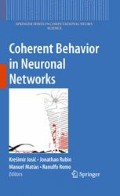Abstract
Hudspeth, Magnasco, and collaborators have suggested that the auditory system works by tuning a collection of hair cells near Hopf bifurcation, but each with a different frequency. An incoming sound signal to the cochlea then resonates most strongly with one of these hair cells, which then informs the auditory neuronal system of the frequency of the incoming signal. In this chapter, we discuss two mathematical issues. First, we describe how periodic forcing of systems near a point of Hopf bifurcation is generally more complicated than the description given in these auditory system models. Second, we discuss how the periodic forcing of coupling identical systems whose internal dynamics is each tuned near a point of Hopf bifurcation leads naturally to successive amplification of the incoming signal. We call this coupled system a feed-forward chain and suggest that it is a mathematical candidate for a motif.
Access this chapter
Tax calculation will be finalised at checkout
Purchases are for personal use only
References
U. Alon. An Introduction to Systems Biology: Design Principles of Biological Circuits. CRC, Boca Raton, 2006.
M. Bear, B. Connors, and M. Paradiso. Neuroscience: Exploring the Brain. Lippincott Williams & Wilkins, Philadelphia PA, 2006.
N.N. Bogoliubov and Y.A. Mitropolsky. Asymptotic Methods in the Theory of Non-linear Oscillations. Hindustan Publ. Corp., Delhi, 1961.
H.W. Broer and G. Vector. Generic Hopf-Neimark-Sacker bifurcations in feed-forward systems. Nonlinearity 21 (2008) 1547–1578.
S. Camalet, T. Duke, F. Jülicher, and J. Prost. Auditory sensitivity provided by self-tuned oscillations of hair cells. Proc. Natl. Acad. Sci. 97 (2000) 3183–3188.
Y. Choe, M.O. Magnasco, and A.J. Hudspeth. A model for amplification of hair-bundle motion by cyclical binding of Ca 2 +to mechanoelectrical-transduction channels. Proc. Natl. Acad. Sci. USA 95 (1998) 15321–15326.
V.M. Eguíluz, M. Ospeck, Y. Choe, A.J. Hudspeth, and M.O. Magnasco. Essential nonlinearities in hearing. Phys. Rev. Lett., 84 (2000) 5232–5235.
T. Elmhirst and M. Golubitsky. Nilpotent Hopf bifurcations in coupled cell systems. J. Appl. Dynam. Sys. 5 (2006) 205–251.
C. D. Geisler and C. Sang. A cochlear model using feed-forward outer-hair-cell forces. Hearing Res. 86 (1995) 132–146.
D.W. Jordan and P. Smith. Nonlinear Ordinary Differential Equations, fourth ed. Oxford University Press, Oxford, 2007.
M. Golubitsky and R. Lauterbach. Bifurcations from Synchrony in Homogeneous Networks: Linear Theory. SIAM J. Appl. Dynam. Sys. 8 (1) (2009) 40–75.
M. Golubitsky, M. Nicol, and I. Stewart. Some curious phenomena in coupled cell networks. J. Nonlinear Sci. 14 (2) (2004) 207–236.
M. Golubitsky and D.G. Schaeffer. Singularities and Groups in Bifurcation Theory: Vol. I. Appl. Math. Sci. 51, Springer-Verlag, New York, 1984.
M. Golubitsky and I. Stewart. The Symmetry Perspective: From Equilibrium to Chaos in Phase Space and Physical Space. Birkhäuser, Basel 2002.
M. Golubitsky and I. Stewart. Nonlinear dynamics of networks: the groupoid formalism. Bull. Amer. Math. Soc. 43 No. 3 (2006) 305–364.
M. Golubitsky, I. Stewart, and A. Török. Patterns of synchrony in coupled cell networks with multiple arrows. SIAM J. Appl. Dynam. Sys. 4 (1) (2005) 78–100.
A.J. Hudspeth. Mechanical amplification of stimuli by hair cells, Curr. Opin. Neurobiol. 7 (1997) 480–486.
A.J. Hudspeth and R.S. Lewis. Kinetic-analysis of voltage-dependent and ion-dependent conductances in saccular hair-cells of the bull frog, rana catesbeiana. J. Physiol. 400 (1988) 237–274.
A.J. Hudspeth and R.S. Lewis. A model for electrical resonance and frequency tuning in saccular hair cells of the bull frog, rana catesbeiana. J. Physiol. 400 (1988) 275–297.
T.S.A. Jaffer, H. Kunov, and W. Wong. A model cochlear partition involving longitudinal elasticity. J. Acoust. Soc. Am. 112 No. 2 (2002) 576–589.
F. Jülicher, D. Andor, and T. Duke. Physical basis of two-tone interference in hearing. Proc. Natl. Acad. Sci. 98 (2001) 9080–9085.
J. Keener and J. Sneyd. Mathematical Physiology Interdisciplinary. Applied Mathematics 8, Springer-Verlag, New York, 1998.
A. Kern and R. Stoop. Essential role of couplings between hearing nonlinearities. Phys. Rev. Lett. 91 No. 12 (2003) 128101.
M.C.A. Leite and M. Golubitsky. Homogeneous three-cell networks. Nonlinearity 19 (2006) 2313–2363. DOI: 10.1088/0951-7715/19/10/04
M. Magnasco. A wave traveling over a Hopf instability shapes the Cochlea tuning curve. Phys. Rev. E 90 No. 5 (2003) 058101-1.
N.J. McCullen, T. Mullin, and M. Golubitsky. Sensitive signal detection using a feed-forward oscillator network. Phys. Rev. Lett. 98 (2007) 254101.
K.A. Montgomery, M. Silber, and S.A. Solla. Amplification in the auditory periphery: The effect of coupled tuning mechanisms. Phys. Rev. E 75 (2007) 051924.
M. Ospeck, V. M. Eguíluz, and M. O. Magnasco. Evidence of a Hopf bifurcation in frog hair cells. Biophys. J. 80 (2001) 2597–2607.
L. Robles and M. A. Ruggero. Mechanics of the mammalian cochlea. Physiol. Rev. 81 (3) (2001) 1305–1352.
L. Robles, M. A. Ruggero and N. C. Rich. Two-tone distortion in the basilar membrane of the cochlea. Nature 349 (1991) 413.
I. Stewart, M. Golubitsky, and M. Pivato. Symmetry groupoids and patterns of synchrony in coupled cell networks. SIAM J. Appl. Dynam. Sys. 2 No. 4 (2003) 609–646.
R. Stoop and A. Kern. Two-tone suppression and combination tone generation as computations performed by the Hopf cochlea. Phys. Rev. Lett. 93 (2004) 268103.
Q. Wang and L.S. Young. Strange attractors in periodically-kicked limit cycles and Hopf bifurcations. Commun. Math. Phys. 240 No. 3 (2003) 509–529.
Y. Zhang. PhD Thesis, Ohio State University.
Acknowledgments
We thank Gemunu Gunaratne, Krešimir Josić, Edgar Knobloch, Mary Silber, Jean-Jacques Slotine, and Ian Stewart for helpful conversations. This research was supported in part by NSF Grant DMS-0604429 and ARP Grant 003652-0009-2006.
Author information
Authors and Affiliations
Corresponding author
Editor information
Editors and Affiliations
Rights and permissions
Copyright information
© 2009 Springer Science+Business Media, LLC
About this chapter
Cite this chapter
Golubitsky, M., Shiau, L., Postlethwaite, C., Zhang, Y. (2009). The Feed-Forward Chain as a Filter-Amplifier Motif. In: Josic, K., Rubin, J., Matias, M., Romo, R. (eds) Coherent Behavior in Neuronal Networks. Springer Series in Computational Neuroscience, vol 3. Springer, New York, NY. https://doi.org/10.1007/978-1-4419-0389-1_6
Download citation
DOI: https://doi.org/10.1007/978-1-4419-0389-1_6
Published:
Publisher Name: Springer, New York, NY
Print ISBN: 978-1-4419-0388-4
Online ISBN: 978-1-4419-0389-1
eBook Packages: Biomedical and Life SciencesBiomedical and Life Sciences (R0)

